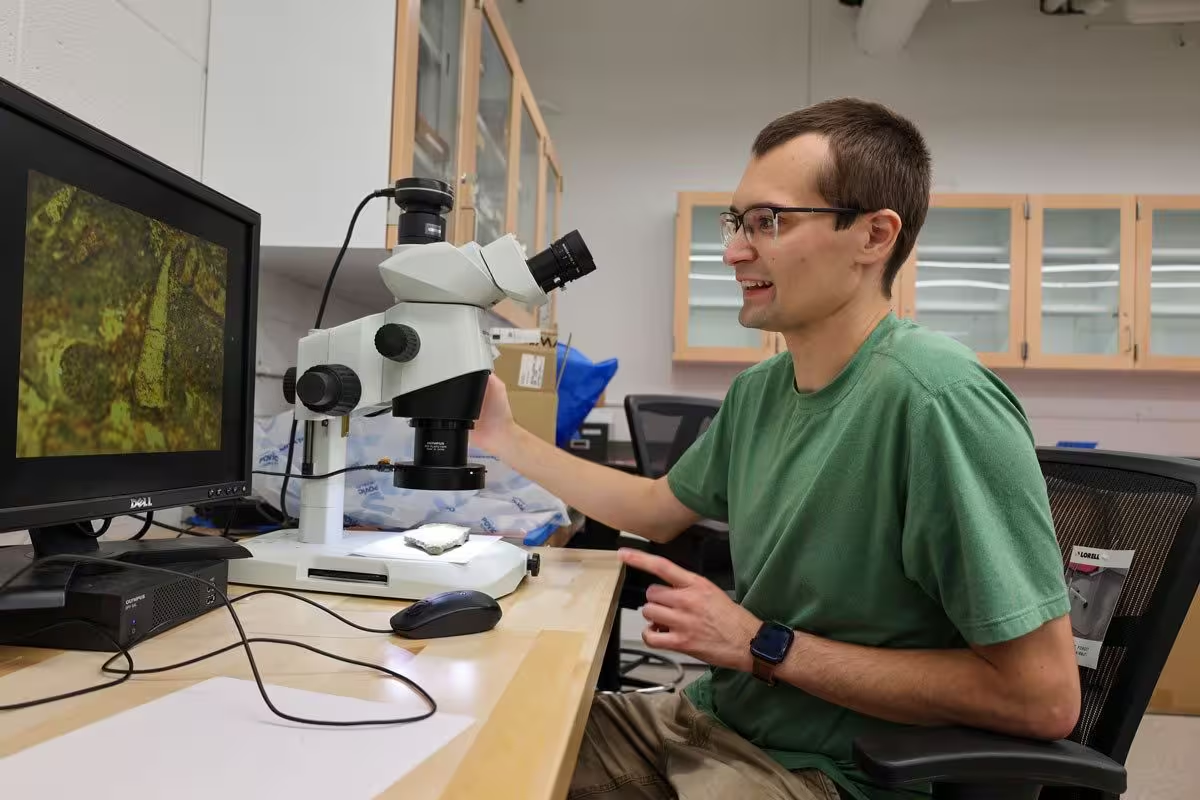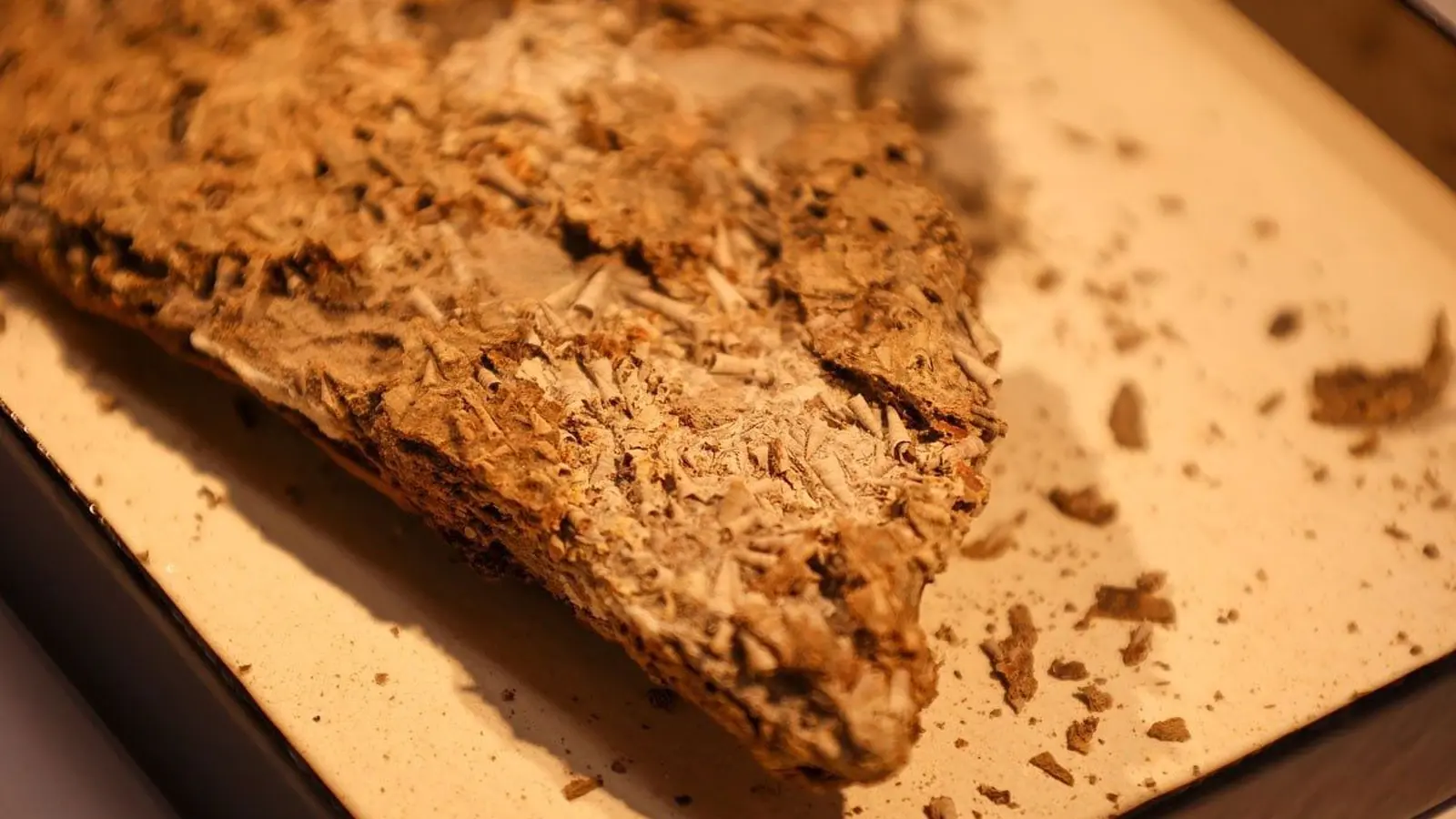6 Minutes
Salterella is a tiny, oddball fossil from the early Cambrian that is forcing scientists to rethink how the first animals learned to build shells and skeletons. Abundant in Cambrian rocks, this conical organism combines a shell and an inner mineral lining in a way rarely seen in the fossil record—making it a critical puzzle piece for paleontologists tracing the origins of biomineralization.
Salterella fossils from Canada. This sample is on loan from the First Nation of Na-Cho Nyäk Dun in collaboration with Yukon Government Heritage. It was sourced from their traditional territory with their permission. Credit: Spencer Coppage for Virginia Tech
A fossil that refuses a comfortable family tree
The early Cambrian (about 538 to 506 million years ago) marks a pivotal interval when most major animal lineages evolved mineralized skeletons and shells. Over half a billion years later, those strategies remain the dominant designs: some animals secreted minerals onto organic scaffolds (like bones and teeth), while others passively glued or aggregated external minerals into protective armor.
Salterella, however, does neither cleanly. Instead of simply secreting a mineral shell or passively cementing sediments, it built a thin conical shell around its body and then packed the shell cavity with a carefully chosen assortment of mineral grains to create a snug internal lining. That unusual “double” construction—external cone plus an intentionally packed interior—has complicated efforts to place Salterella on the tree of life.
Historically, Salterella has bounced between very different groups: once aligned with cephalopods (squids and octopuses), later likened to gastropod relatives, then tentatively linked to jellyfish ancestors, and at times compared to worms. By the 1970s it and a comparable fossil, Volborthella, were separated into a distinct group largely because they didn’t fit anywhere else. For decades they remained an evolutionary orphan—ubiquitous in Cambrian rocks but poorly understood.

Prescott Vadya, geosciences graduate student, has taken a deep dive into Salterella, an ancient and unusual organism that sported both a shell and a skeleton. Credit: Spencer Coppage for Virginia Tech
How researchers cracked part of the mystery
Prescott Vayda, a geosciences graduate student, led a multi-year, multi-institutional study that re-examined Salterella and its kin using field collections and lab-based mineralogical analysis. Vayda and colleagues gathered specimens from classic Cambrian localities—Death Valley, Yukon in Canada, and Wythe County in Virginia—then analyzed shell shape, grain selection, and crystal structure with modern microscopy and geochemical techniques.
The results painted an unexpected portrait. Salterella didn’t trap a random slurry of sediments. It was selective: some grains (like clays) were excluded, quartz was tolerated but not preferred, and heavier or rarer minerals—what the paper playfully calls “choice” grains such as titanium-rich minerals—appear preferentially incorporated. That pattern implies active selection, not passive filling.
Selective grain collection suggests biological functionality. The inner mineral lining could have helped stabilize the animal in soft sediments, altered its center of mass for locomotion, or even played a role in feeding—perhaps functioning as ballast or as a substrate for capturing food particles. To collect and place grains, Salterella likely had appendages or structures capable of picking and manipulating particles, a behavioral inference with important evolutionary implications.
Where Salterella may sit among living groups
Combining morphology, ecology, and shell microstructure, Vayda and colleagues proposed a provocative solution: Salterella and Volborthella may fit within the cnidarian lineage—the group that includes modern corals, sea anemones, and jellyfish. Cnidarians today number more than 9,000 species and display a variety of life habits, from sessile corals that secrete calcium carbonate to pelagic jellyfish.
Assigning Salterella to the broader cnidarian branch helps explain why its construction is unique: cnidarians already experiment with different modes of skeleton formation, and an early, now-extinct experiment in mineral aggregation and selective packing could be a lost side branch. As Vayda put it, "Finding the right place for these fossils is important for our understanding of how animals evolved skeletons and shells."
Why this matters for evolutionary science
Reconnecting Salterella to a living group rewrites a small but important page of biomineralization history. If an early cnidarian relative used both an outer shell and an inner packed lining, it expands the known repertoire of early skeleton-building strategies and shows that evolutionary experimentation in the Cambrian was even richer than previously known.
Index fossils such as Salterella are also practical tools: their abundance and stratigraphic consistency make them markers for dating rock layers. But beyond dating rocks, these fossils encode behaviors, environmental interactions, and construction techniques—clues that deepen our picture of early animal ecosystems.
Expert Insight
"Salterella offers a rare window into early animal engineering," says Dr. Lara Emerson, a paleobiologist not involved in the study. "It reminds us that evolution explores many structural solutions, some of which leave few descendants but reveal key stages in the buildup of modern anatomical complexity."
Restoring Salterella to the broader narrative of biomineralization may illuminate why certain mineral strategies persisted while others vanished. For researchers like Vayda, the payoff is both scientific and philosophical: "It’s about truly learning where we come from and the history of life on Earth," he says. The tiny, enigmatic Salterella is proving to be a surprisingly eloquent storyteller.
Source: scitechdaily
Comments
datapulse
Is the grain selection really biological or just taphonomy? sounds cool but I want more data, like wear marks or appendage traces
bioQuark
Whoa, Salterella packing 'choice' minerals? mind blown... tiny engineers 500M yrs ago, wow. if true, that rewrites a lot, huh


Leave a Comment